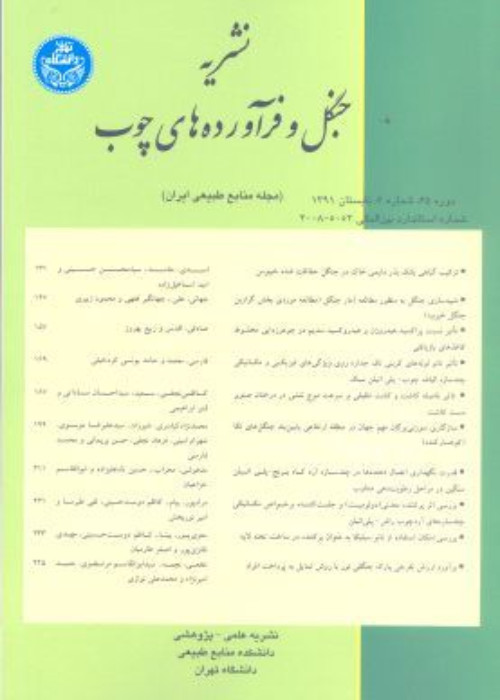Four-year monitoring of crown dieback to determine the characteristics of Persian oak trees susceptible to crown dieback
Author(s):
Article Type:
Research/Original Article (دارای رتبه معتبر)
Abstract:
In the present study, the crown dieback of Persian oak trees was monitored over a period of four years (2019 to 2022) in order to determine the characteristics of oak trees that are sensitive to crown dieback in the Mele-Siah forests of Ilam. Two plots, with varying areas in order to include 100 oak trees, were selected on the northern and southern slopes. The characteristics of each tree, including the diameter at breast height, tree height, and the large and small diameters of the crown, were measured and recorded. The crown dieback of each tree was evaluated based on the percentage of crown dieback over the course of four years at the end of the summer season, and the trees were divided into four classes of crown dieback. The results showed that there is variation within the species in terms of the extent of crown dieback. On the northern slope, the majority of trees were in the declining and less than 50% crown dieback classes, while on the southern slope, the majority of trees were in the healthy and more than 50% crown dieback classes. The healthy class had the lowest average diameter at breast height, height, and crown area, while the higher crown dieback classes had higher averages for these characteristics. Additionally, the results showed that there is variation within the species in terms of the annual variability of crown dieback intensity. In the northern site, 17 trees and in the southern site, 14 trees were moved from the healthy and low crown dieback classes to the higher crown dieback classes. The results indicated that the transplanted trees had larger diameters at breast height, heights, and crown areas compared to the trees in the same class that were not transplanted. It was concluded that trees with larger dimensions in terms of diameter at breast height, height, and crown area, which are also older, are more sensitive to dieback. Conversely, trees with less crown variability or greater crown health have greater adaptability or tolerance to drought conditions, which can be used to produce resilient seedlings for the restoration of dieback-affected forests. The findings of this study can be utilized in the identification and protective management of forest trees that have not yet experienced decline or are situated near affected trees and stands.
Keywords:
Language:
Persian
Published:
Journal of Forest and Wood Products, Volume:76 Issue: 2, 2023
Pages:
91 to 101
magiran.com/p2626413
دانلود و مطالعه متن این مقاله با یکی از روشهای زیر امکان پذیر است:
اشتراک شخصی
با عضویت و پرداخت آنلاین حق اشتراک یکساله به مبلغ 1,390,000ريال میتوانید 70 عنوان مطلب دانلود کنید!
اشتراک سازمانی
به کتابخانه دانشگاه یا محل کار خود پیشنهاد کنید تا اشتراک سازمانی این پایگاه را برای دسترسی نامحدود همه کاربران به متن مطالب تهیه نمایند!
توجه!
- حق عضویت دریافتی صرف حمایت از نشریات عضو و نگهداری، تکمیل و توسعه مگیران میشود.
- پرداخت حق اشتراک و دانلود مقالات اجازه بازنشر آن در سایر رسانههای چاپی و دیجیتال را به کاربر نمیدهد.
In order to view content subscription is required
Personal subscription
Subscribe magiran.com for 70 € euros via PayPal and download 70 articles during a year.
Organization subscription
Please contact us to subscribe your university or library for unlimited access!


